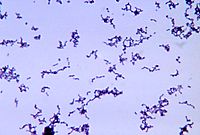
Photo from wikipedia
Cutibacterium acnes (formerly Propionibacterium acnes) is recognized as a pathogen in foreign-body infections (arthroplasty or spinal instrumentation). To date, the direct impact of C. acnes on bone cells has never… Click to show full abstract
Cutibacterium acnes (formerly Propionibacterium acnes) is recognized as a pathogen in foreign-body infections (arthroplasty or spinal instrumentation). To date, the direct impact of C. acnes on bone cells has never been explored. The clade of 11 C. acnes clinical isolates was determined by MLST. Human osteoblasts and osteoclasts were infected by live C. acnes. The whole genome sequence of six isolates of this collection was analyzed. CC36 C. acnes strains were significantly less internalized by osteoblasts and osteoclasts than CC18 and CC28 C. acnes strains (p ≤ 0.05). The CC18 C. acnes ATCC6919 isolate could survive intracellularly for at least 96 hours. C. acnes significantly decreased the resorption ability of osteoclasts with a major impact by the CC36 strain (p ≤ 0.05). Genome analysis revealed 27 genes possibly linked to these phenotypic behaviors. We showed a direct impact of C. acnes on bone cells, providing new explanations about the development of C. acnes foreign-body infections.
Journal Title: Scientific Reports
Year Published: 2017
Link to full text (if available)
Share on Social Media: Sign Up to like & get
recommendations!